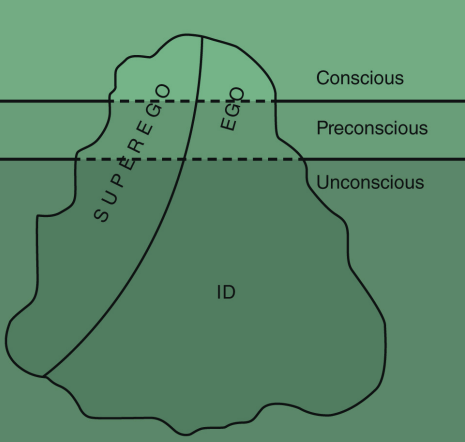cp final
1/56
There's no tags or description
Looks like no tags are added yet.
Name | Mastery | Learn | Test | Matching | Spaced |
|---|
No study sessions yet.
57 Terms
topographical map of the mind
mind is divided into conscious, preconscious, and unconscious

structural model of the mind
mind is divided into id, ego, and superego
id
fundamental biological drives=sexual/sensual/aggressive; pleasure principle: seeks immediate gratification of basic drives
ego
mediates between id/superego; recognizes/responds to external demands of real world; reality principle: mediates between id’s desire, superego’s ideals, + demands of real world; ego strength very important to psychological health
superego
society’s rules/norms; what we’re supposed to do (from parents, families, culture)
ego ideal
image of what you would like to be; internalized ideals, goals, + aspirations
denial
being unable to recognize/acknowledge threatening experiences
repression
anxiety-provoking thoughts + memories disappearing into the unconscious (motivated forgetting)
regression
retreating to coping strategies characteristic of earlier stages of development
projection
attributing one’s own negative motives + impulses to others
reaction formation
adopting thoughts + behaviors that are the opposite of what one really thinks or wants to do
displacment
directing pent-up impulses toward a safer substitute rather than the target that aroused the impulses
rationalization
providing socially appropriate, but false, explanations for one’s behavior
intellectualization
dealing with upsetting experience sin an overly logical manner, usually with reference to some non-emotional explanatory theory or scientific principle
compensation
coping with feelings of inferiority in one area by working to become superior in another area
sublimation
channeling the expression of unacceptable impulses into more socially acceptable activities
hysterics/neurotics
patient displays symptoms such as paralysis, amnesia, blindness, numbness, inability to speak, ect; however, no physical cause can be found
case of anna o
lot of physical symptoms, like trance-like state in evenings; breuer urged her to describe in detail her hallucinations; vivid recollections of forgotten events while in trace lifted symptoms during normal times
cathartic method
joseph brueur; “talking cure”; use of hypnosis to take through traumatic events + relieve physical symptoms
free association
freud; useful for patients who could not be hypnotized; asked them to lie down on couch, relax, + describe whatever thoughts, feelings, or memories came to mind without filtering/altering
transference
the displacement of feelings towards other people onto the therapist; past relationship with an object is repeated; by definition regressive; basic mechanisms are displacement + projection; behaviors + emotions reflecting unconscious process in which childhood feelings + conflicts about primary caregivers + other signifiant people are projected onto therapist
countertransference
the therapists unconscious reactions towards the client based on personal history/conflicts and/or patient’s projections; requites conscious + active exploration from therapist; useful only when therapist can distinguish between their own reaction (caused by history) and patient’s projections
resistance
as therapy progresses towards deeper understanding of unconscious conflicts, client experiences increased anxiety; forgetting appointments, becoming emotionally detached; re-enactments of earlier patters, shows treatment is working
psychic determinism
all psychic processes (associations between memories, ect) are determined by unconscious processes; freudian slips, mental images, memory failures are all psychologically important; seemingly unrelated thoughts or topics should be examined by psychologist to evaluate unconscious meaning
interpretation
therapists provide insight into how client’s current thoughts, feelings, or behavioral patterns connect to underlying conflict; if patient is ready, this paves wait for therapeutic process
insight
if interpretation makes sense to patient cognitively + emotionally, patient able to see behavior pattern/problem in new way
working through
after interpretation + gaining insight, patient keeps recognizing newly discovered patterns + practice new ways of thinking
goals of psychoanalytic/psychodynamic psychotherapy
gain conscious + emotional insight into underlying causes of problems
work through + fully explore implications of insights gained for everyday life
strengthen ego’s control over id + superego, thereby bolstering client’s mastery over sources of conflict
role of the therapist in psychodynamic therapy
neutral/almost no self-disclosure; absence of objective information about therapist so patient can freely fantasize/project onto therapist any attribute they associate with past important figures (object relations) in their life; neutral is NOT cold/unresponsive; must still be empathic, supportive, reflective to create emotional safety; maintain “free-floating”/evenly divided attention between trivial + momentous events as well as body language + spoken language
analysis of everyday behavior
reporting activities outside of treatment + what patient says + does in sessions; pay attention to detains, body/spoken language, “mistakes”, memory losses, alteration, repetition, humorous comments (defenses)
analysis of dreams
defenses go to sleep with you, so unconscious materials come to surface in dreams; each person has their own dictionary of what symbolic representations mean, so dreams can be revealed in same way as free-association technique
manifest content
what you see in dreams (the disguised forms)
latent content
unconscious wishes, ideas, fantasies, impulses; appear in the disguised forms
analysis of transference
work to understand + point out meaning of client’s feelings/behavior, help them see + understand meaning of transference reaction
psychodynamic psychotherapies
influenced by freud, “neo-freudians” propose alternatives to add to original theories; emphasize role of ego in motivating psychological growth; still recognize importance of early relationships, also focus on developmental stages of childhood; focus on interpersonal aspects - not just as transferential material, but as healing aspects in and of itself
interpersonal psychotherapy (IPT)
1970s, gerald klerman + myrna weissman; initially drug treatment for women with depressive disorders
humanistic psychotherapy
carl rogers (1902-87); person-centered therapy